You may have heard the term raptor before and not known exactly what it meant. After all, it is often used to describe many different species that may not seem like they have much in common. In the article below, learn exactly what a raptor is, and meet some of the different types of raptors in the world.
Ready to learn more? Let’s dive in!
What Is a Raptor?
When you first think of the term “raptor,” you may think of dinosaurs. However, this term also applies to species that exist today.
A raptor is a hypercarnivorous bird of prey. A hypercarnivore is any animal that has a diet made of 70 percent meat, whether this is achieved through predation or scavenging carrion. The word raptor comes from the Latin word rapere, which means to ‘seize’ or ‘plunder.’ This can be a good way to describe just how these birds swoop down and capture their prey.
Many birds are carnivores, however. For instance, some species of songbirds eat insects, which makes them carnivorous. These species wouldn’t be raptors, though. Continue reading below to learn the other traits that are required for a raptor to be a raptor.
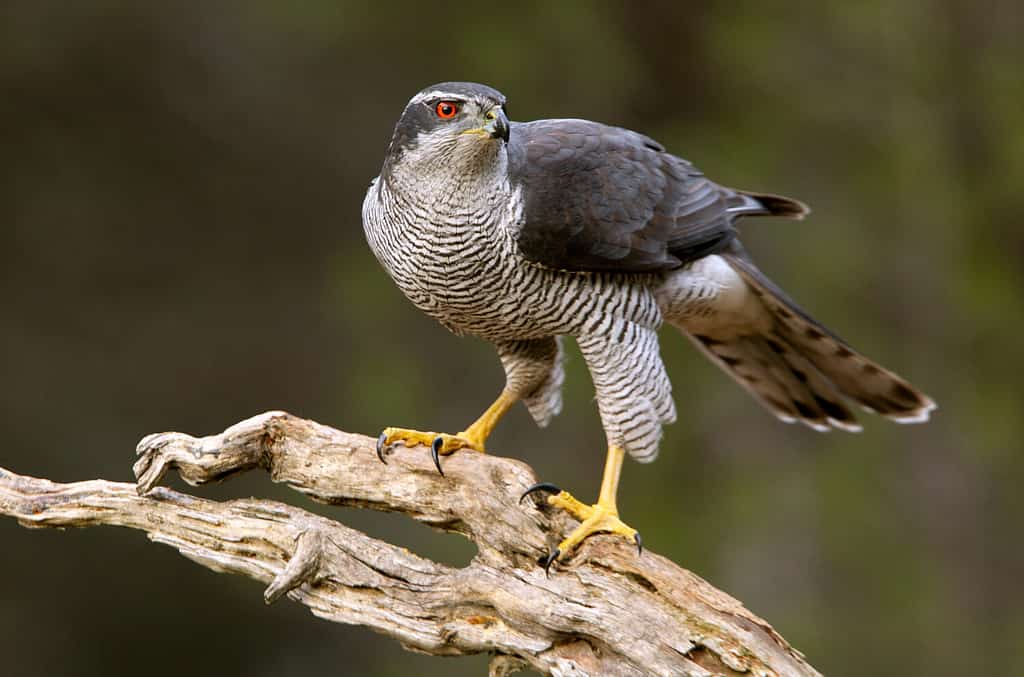
Raptors are birds of prey that share several different characteristics.
©Jesus Giraldo Gutierrez/Shutterstock.com
5 Characteristics of Raptors
Along with being carnivores, four other major qualities separate raptors from other species. Keep reading below to learn about these characteristics and why they are important to these birds of prey.
1. Excellent Eyesight
Have you ever heard the expression “eagle-eyed”? As it turns out, this expression comes from a place of truth.
Eagles and other types of raptors are known for their keen eyesight. This keenness comes from a variety of factors, from the size and shape of their eyes to the muscles used to control their vision. Nocturnal raptors, such as owls, also share this excellent eyesight, although theirs is more adept for night-time vision.
Along with having eyelids similar to that of humans, raptors also have a third eyelid known as a nictating membrane. This is a see-through eyelid that helps keep their eyes moist and protected. It’s important that birds are able to see through this eyelid, as it helps keep debris out of the eye while they are flying. You may find nictating membranes in other species as well, such as frogs.
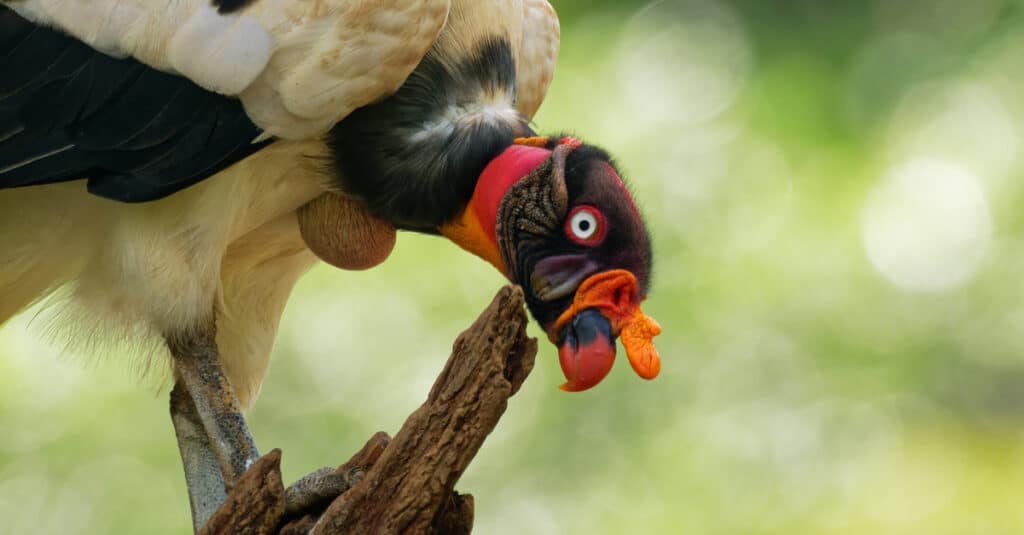
Birds of prey have keen eyes designed to help them spot food.
©Martin Pelanek/Shutterstock.com
2. Curved or Hooked Bills
Different birds have different types of bills or beaks. These differences in shape help each species thrive by aiding in their pursuit of food. For seed-eating birds, they’ll often have large, cone-shaped bills that can easily open up seeds. For raptors, they have curved or hooked bills.
When you look at a bird’s bill, you’ll notice it is made of a lower jaw and an upper jaw. For a raptor, the upper portion will be longer than the lower portion. It will curve into a sharp hook at the tip. This helps raptors to rip and tear flesh into bite-size pieces.
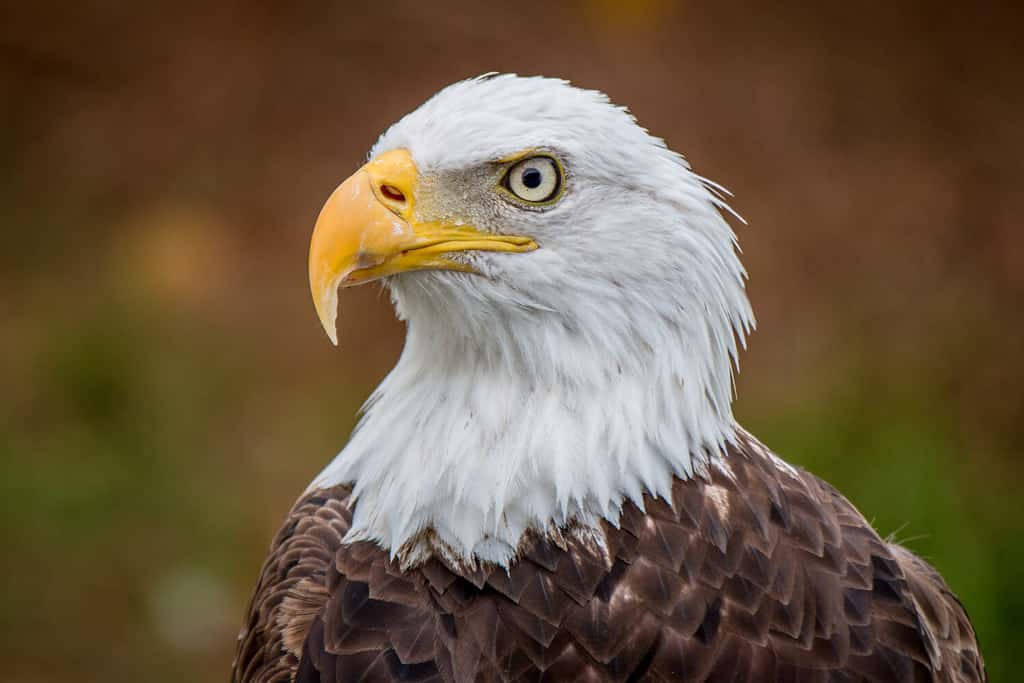
The hook shape of a raptor’s beak helps them tear food.
©Kevin Tubbergen/Shutterstock.com
3. Strong, Sharp Talons
When you receive the advantage of flight, it comes at a price. Raptors, like all species of birds, lack traditional arms. While they have the same bones as our arms (radius, ulna, humorous, etc.), these bones are used to create their wings. Because of this, they lack an easy way to reach out and grab their food.
That’s where the importance of their talons comes in. Raptors have large, strong feet with razor-sharp talons. These can be used to capture prey, especially while in flight. The harpy eagle has the largest talons. At 5 inches long, their claws are larger than that of a grizzly bear’s!

Like other birds of prey, osprey eat fish and often carry them in their talons to a place where they can safely consume their meal.
©Gregory Johnston/Shutterstock.com
4. Carnivorous
As mentioned earlier above, all raptors are hypercarnivores. However, not all raptors hunt for their food. While the majority of raptors are expert hunters, some, such as vultures, are scavengers instead.
5. Active Parents
Another characteristic of raptors is that they are active parents. Often, the female will stay with the nest while the male hunts. They will care for their young while they are in the nest, as well as afterward. In some species, offspring will go on to establish their own territories near that of their parents.
Parents will even care for young chicks that unintentionally leave the nest early. This is why it is important not to interfere if you see a chick that appears to be abandoned and instead contact your local wildlife resources. They will be able to better determine if the chick is being cared for outside of the nest or if it was truly abandoned.
7 Types Of Raptors
There are around seven different types of birds that are considered to be raptors. These are species that meet all of the characteristics above.
Before reading, though, it’s important to note that this is just a broad overview of each category of raptor. As you’ll learn more below, there can be dozens of different species within each type of raptor. For instance, there are almost two dozen species that fall into the category of vultures and condors.
With that in mind, continue reading below!
1. Eagles
Eagles are one of the most well-known types of raptors. There are around 68 different species of eagles found throughout the world. They comprise several different genera in the family Accipitridae. The majority of true eagles make up the genus Aquila, although there are several other genera that include eagle species.
Most eagle species are found in Europe, Asia, and Africa. Only 14 of these species are found elsewhere, with North America having two, South America nine, and Australia three.
Eagles are included on the coat of arms for Austria, the United States, and Kotka, Finland. The bald eagle is the national bird of the United States. In some parts of the world, eagles are trained to attack drones, which is already a natural behavior in the raptors, who may mistake drones for prey.

One of the most well-known birds of prey is the eagle.
©PHOTOOBJECT/Shutterstock.com
2. Hawks
There are two groups of hawks. True hawks are those in the genus Accipiter. Hawks in the genus Buteo are considered to be hawks but may be called buzzards outside of America. Other terms used to distinguish between these two groups of hawks include accipitrine hawk and buteonine hawk.
Hawks rank highly in intelligence. Unlike the majority of birds, they lack the ability to perceive ultraviolet light. However, like all raptors, hawks still display keen eyesight that aids them in hunting and observing their environment.
These raptors have the unique ability to thrive in a variety of ecosystems and climates. However, regardless of species, one common observation is that hawks prefer to live in open spaces. This can include spacious forests around swamps, prairies, grasslands, and even deserts.
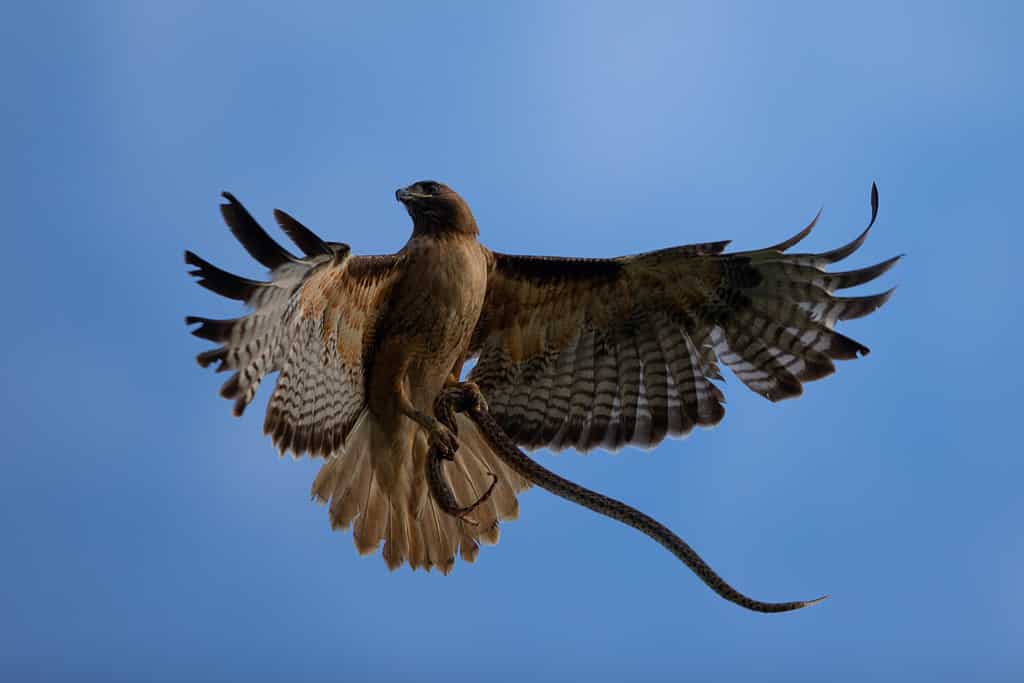
Hawks use their sharp talons to pick up dangerous snakes and drop them from extreme heights.
©ranchorunner/Shutterstock.com
3. Owls
There are over 200 species of owl, all within the order Strigiformes. They are visually distinct from most other raptors, with large, broad faces and dense wings designed to be silent while in flight.
One of their most noticeable features is the circular disk around each eye. These facial discs are designed to collect sounds, allowing owls to hear even the smallest of noises around them. This is highly beneficial considering the small stature of their prey, which mainly consists of some insects and rodents. Rarely, owls may also consume fish.
Owls are known for regurgitation. Upon eating, they will regurgitate difficult-to-digest parts, such as bones, into small pellets.
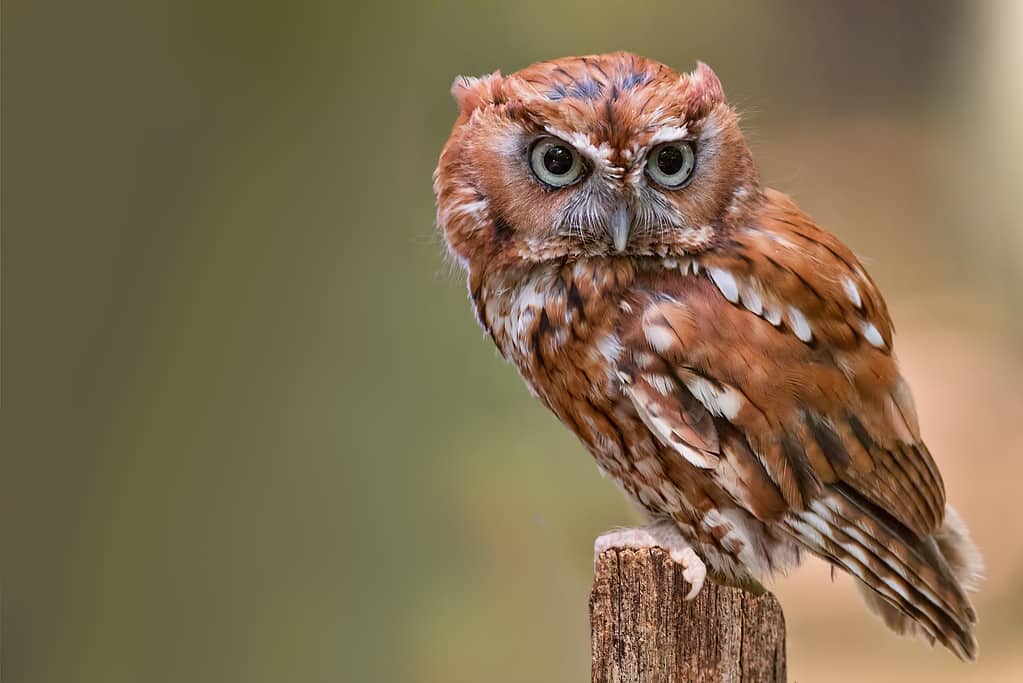
Owls have specialized feathers that allow them to fly without a sound.
©Jens_Lambert_Photography/iStock via Getty Images
4. Falcons
Falcons are raptors in the genus Falco. This genus includes around 40 different species, including kestrels. The fastest animal in the world, the peregrine falcon, falls into this category. Peregrine falcons are known for their high-speed dive, with the fastest recorded reaching a top diving speed of 242 miles per hour.
Species of falcons are known for their high-speed wings. These are short, flat wings that end in a point, and while not great for soaring, they can help falcons quickly catch prey while in flight.

One type of falcon, the peregrine falcon, is the fastest animal in the world.
©Harry Collins Photography/Shutterstock.com
5. Vultures and Condors
Vultures and condors are scavengers that are often included with other types of raptors or birds of prey despite not traditionally hunting their food. There are two categories of vultures.
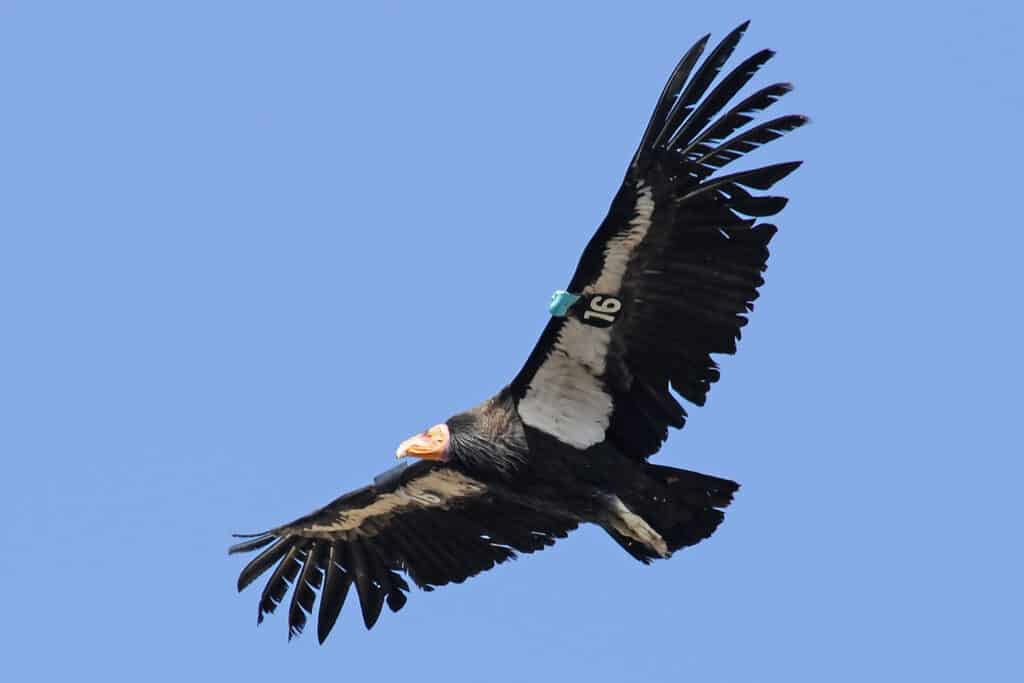
Raptors, like vultures and condors, scavenge for their food rather than hunt for it.
©Brian A Wolf/Shutterstock.com
New World vultures are those found in the Western Hemisphere. They belong to the family Cathartidae. New World vulture (and condor) species include:
- Black vultures
- Turkey vultures
- Lesser yellow-headed vultures
- Greater yellow-headed vultures
- California condors
- Andean condors
- King vultures.
Old World vultures are those found in the Eastern Hemisphere. They belong to the family Accipitridae, along with many other raptor genera. There are no Old World condor species. Vultures that fall into this category include:
- Cinereous vulture
- Griffon vulture
- White-rumped vulture
- Rüppell’s vulture
- Indian vulture
- Slender-billed vulture
- Himalayan vulture
- White-backed vulture
- Cape vulture
- Hooded vulture
- Red-headed vulture
- Lappet-faced vulture
- White-headed vulture
- Bearded vulture
- Egyptian vulture
- Palm-nut vulture.
Vultures and condors are essential to healthy ecosystems. They help remove diseases and waste that could otherwise pose a threat to other species.
6. Ospreys
Species that fall into the category of “osprey” may go by many other names. This includes sea hawk, river hawk, or fish hawk. However, despite the similarities in name, an osprey is not a hawk, although they are a raptor.
There is only one living species of osprey: Pandion haliaetus. There are several subspecies throughout the world, however. Extinct species within the genus Pandion include Pandion homalopteron and Pandion lovensis. This genus is found within the order Accipitriformes, which includes several other raptors (but not falcons).
Ospreys have a diet that is almost exclusively made up of fish. Other inclusions in their diet are rodents, small mammals such as rabbits, reptiles such as snakes or turtles, amphibians, and even other birds. On even rarer occasions, ospreys have been observed scavenging carrion, such as white-tailed deer and opossums.
Because ospreys are mainly fish-eating raptors, they have some unique features that other birds of prey may not have. One example of this would be their closable nostrils. This helps when they are diving in the water, as it prevents water from flooding the nostrils. They also have a dense, oily plumage. These specialized feathers are designed similarly to that of waterfowl and allow the osprey to enter the water without becoming too heavy or waterlogged.
During the mid-20th century, ospreys were one of the avian species most heavily affected by insecticides. This is because insecticides sprayed on plants could run off into waterways after storms, infecting the local fish. Chemicals in these insecticides caused thin-shelled eggs that would break easily, resulting in a population decline.

There is only one living species of osprey but several subspecies.
©BlueBarronPhoto/Shutterstock.com
7. Kites
Kites make up three different groups in the family Accipitridae: Elaninae, Milvinae, and Perninae. Despite including several different species, these birds are some of the less well-known types of raptors. However, they are included in several of Aesop’s fables, as well as ancient Egyptian mythology.
The kite is most closely related to eagles and hawks. However, their appearance resembles that of species within the genus Falco.

Some species of kites are highly endangered.
©John P Ruggeri/Shutterstock.com
The photo featured at the top of this post is © David Brace/Shutterstock.com
Thank you for reading! Have some feedback for us? Contact the AZ Animals editorial team.






